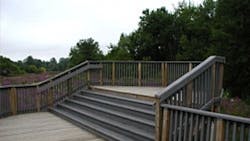Think Outside the Building
With the current emphasis on designing and maintaining "healthy buildings," we all are aware of the benefits of natural light, ventilation and windows with views. What might be even better than views to the outdoors? How about being submersed in the outdoors?
Learning and the Outdoor Environment
Often overlooked as a learning environment, the outdoors may offer the most diverse range of educational experiences on any campus. Studies show that people have a natural, biological need to affiliate with nature, an attraction called biophilia. Natural environments have been linked to improved information recall, creative problem-solving and creative thinking. Additionally, outdoor experiences produce positive physiological and psychological responses, including reduced stress and a general feeling of well-being.
Incorporating outdoor learning features into education facilities provides a positive influence on those who view and use these spaces. In addition, such spaces create an identity that communicates to the surrounding community that the institution is committed to being environmentally responsible. With limitless opportunities to learn and explore, the outdoors can provide many unique, memorable experiences. The question then becomes, how does an education facility transform outdoor spaces to provide positive learning experiences for those who use them?
Educational Opportunities
Whether it is an elementary school, high school or college campus, outdoor space can be transformed into an integral piece of the learning equation.
Obvious themes for outdoor learning revolve around ecology and environmental sciences, as natural environments provide hands-on opportunities to explore flora and fauna, ecosystems and weather-related lessons. Outdoor laboratories can be constructed for outdoor experiments. In addition, many science-related lessons performed outdoors can encourage discussion, promote cause-and-effect thinking, and increase students' ability to retain and retrieve information.
With green and sustainable technologies at the forefront of national interest, outdoor learning environments provide a unique opportunity to teach about these technologies and how they relate to real-world applications such as recycling, composting, rainwater reuse and renewable energy.
Stage-like outdoor spaces can be designed to provide the perfect backdrop for outdoor performances and lectures. Outdoor galleries or sculpture gardens can be incorporated into the curriculum, or simply used to generate discussion and promote social interaction.
Social and behavioral well-being also is an important part of learning. It is well-documented that outdoor spaces have proven to have a positive effect on children with autism and attention deficit hyperactive disorder (ADHD). Creating spaces that accommodate the special needs of these children can provide a calming, therapeutic effect.
Planning, Design, Construction and Maintenance Considerations
Critical to the success of any outdoor space is identifying its opportunities and constraints. Performing site analysis and developing goals for the space are key first steps in the development of outdoor classrooms. It is important to include educators, administrators and facility managers early in the planning and design process to ensure a usable, long-lasting, flexible space that provides for multiple uses and experiences.
Important design considerations include accessibility and features that accommodate all users. Ramps and raised planters can be incorporated to ensure that everyone can fully experience all that the space has to offer. Signage also is important, as this enables the benefit of learning from lessons embedded in the space, even if there is no one giving a formal lesson.
Hands-on learning opportunities arise during construction of these spaces, such as measuring, reading schematic plans, using tools, following directions and working with others. Students and community members are able to come together and create something in which they can take pride and feel a sense of accomplishment.
Finally, understanding the maintenance needs of these outdoor spaces is critical to their long-term enjoyment. The facility managers and individuals who will be responsible for maintaining these spaces should participate throughout all phases of the project, including design and construction. Their involvement enables them to gain an understanding of the design intent, voice concerns and develop a vested interest in the success of these spaces.
Development of outdoor classrooms may even identify opportunities for maintenance-reduction strategies such as transforming unused lawn areas to no-mow wildflower meadows. Maintenance also can be accomplished by enlisting the help of local volunteer groups such as gardening clubs and community groups working in close conjunction with the education facility.
Christopher E. Green, RLA, ASLA, LEED AP, is with Gilmore and Associates Landscape Architect, which has offices in New Jersey and Pennsylvania. Chris has been designing outdoor spaces for more than 10 years.
